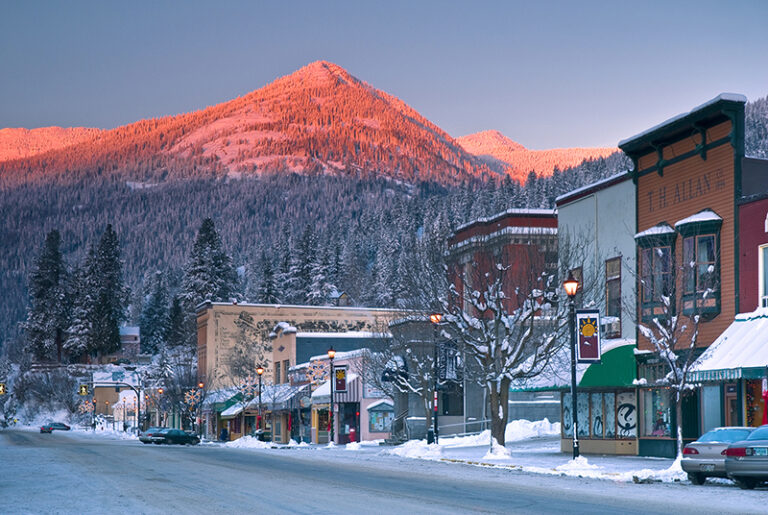Bicycling The Lewis & Clark Trail
Michael McCoy & Adventure Cycling Association
Falcon, June 2003, 240 pages.
As the Lewis & Clark Bicentennial celebration enters its homestretch, one lasting contribution that will continue to roll on is the engaging book, Bicycling the Lewis & Clark Trail. Just as Thomas Jefferson commissioned the Corps of Discovery to seek a passageway through North America to the Pacific Ocean, the Adventure Cycling Association accepted the challenge to create a bicyclist’s roadmap retracing the historic Corps’ path. Though the Corps traveled two hundred years ago over river and land by boat and foot to explore a frontier of many unknowns, today cyclists of the twenty-first century can use a planned, plotted and mapped trail-guide which covers the expedition from Hartford, Illinois to Astoria, Oregon.
Each chapter of the guide encapsulates information on a segment of the route, historical snippets, plus an easy-to-read map with mileage. For the cyclist who wants to trace any of the 3,200 miles of the incredible trek, this book offers well-researched directions for traveling along low-traffic roads while at the same time enjoying the privilege of viewing history first hand.
In my own travels, retracing some of the meanderings of the Corps, I have canoed the Missouri River, staked my tent in sites from Fort Benton, Montana to Fort Clatsop in Oregon, and trekked through Dayton and Walla Walla, Washington. With each excursion I couldn’t help but continually be fascinated by the astonishing journey taken two centuries ago. Now, Bicycling the Lewis & Clark Trail is calling me to explore the incredible expedition by road on my two wheels (and modern camping equipment!) Any history buff who likes to ride a bike and has the desire to take a trip back in time will find this book most satisfying with great information, exquisite photography and user-friendly maps. For the adventurous cyclist who has the undaunted courage to retrace and embrace history, Bicycling the Lewis & Clark Trail is a must.
Patricia Campbell Kowal
Planet of Slums
Mike Davis
Verso 2006, 228 pages.
I recently saw the movie, City of God, and coming from an architectural background, I was fascinated with the progression throughout the movie of urban growth within the slum settlements of Rio de Janeiro. Small quaint-like villages in the late 1960s quickly became pulsing concrete jungles by the early ’80s. Mike Davis, in his new book, Planet of Slums has written about this global phenomenon, or catastrophe rather.
According to Davis, most of the world’s population now lives in urban conditions so squalid that they would barely be comprehensible to those of us accustomed to perusing the likes of Dwell magazine. Charles Dickens be damned. This is not just the overcrowded tenements of the Industrial Revolution. In Cairo’s City of the Dead, over one million people now live in adapted tombs. In Lima, it is common for 85 people to share a water tap and 93 to use the same toilet. In Buenos Aires over 100,000 squatters have occupied abandoned buildings. In Mumbai over one million now live on the streets, and “caged-men” in Hong Kong live in spaces on average that are only 19.4 square feet.
With exploding global populations and an agricultural revolution that requires fewer to work the fields, for the first time in the history of the world, the urban population now exceeds the rural. This urbanization, however, is not the walkable, cultural centers that we have come to love throughout Europe; here the poor are relegated to edge of the city. In fact, these are no longer even characterized as cities. Now we have the megacity with a population of over 8 million, or hypercities with populations over 20 million, or simply conurbations, agglomerations of megacities that have grown together over time.
In great detail Davis chronicles attempts over the years, both altruistic and otherwise, to address the planet of slums. The States themselves seem to have abandoned these areas years ago, providing no water, no sanitation, no schools and no hospitals. The current approach appears to be complete apathy toward the fate of these human beings on a global scale.
As we in developed nations turn a blind eye to this, Davis asks if there will be revolt or urban involutions? Like the slums depicted in the City of God, what kind of new world order have we created and where is our collective humanity? The devastation wracked on human lives is immeasurable when no one seems to care.
Juliet Sinisterra
The Essential Grizzly: The Mingled Fates of Men and Bears
Doug Peacock, Andrea Peacock
Lyons Press, May 2006, 264 pages.
In The Essential Grizzly, Doug Peacock teams up with his wife, Andrea, to share their undying love of bears and examine the bear’s role and place in human society.
The Peacocks examine our relationship with bears, particularly grizzly bears, from biological, evolutionary, social, political, and at times, philosophical standpoints. By using these different perspectives they are able to paint a more complete portrait of the bear and our relationship to it.
The reader comes to understand the grizzly bear and its behavior in a very clear sense. These creatures begin to lose some of their mystique and become what they truly are: carnivores trying to find a way to survive in shrinking and dangerous habitats. As the reader comes to understand the bear, the reader comes to realize that many of the beliefs we hold of bears are simply wrong.
The author’s point out that bears are not cold-blooded killers. A bear may stalk a person in the woods, but this is less because the person is being hunted and more because the person is invading the bear’s territory. Wouldn’t you keep an eye on a bear if it was in your neighborhood? Bears can and have killed humans, but the blood-thirsty, man-eating bear is largely a myth created by the media.
Using this notion as a foundation, the author’s go on to depict the bear as a rational, fearful, and loving creature. They successfully dissect much of the fear that surrounds bears and replace it with appreciation and reverence. The reader is left with a genuine feeling of concern for the bear and a greater respect for the bear’s territory. It is hard for many of us to accept that there are places on this earth where we are not necessarily entitled to go, but the Peacock’s make it very clear that in the bear’s habitat we are not the alpha-creature.
The most profound argument made in the book is, somewhat expectedly, their philosophical contribution. They argue that despite our modernized society, bears still represent a very real and very terrifying threat to our fragile bodies. Knowing potential predators such as the grizzly bear are lurking in our forests is essential to our humility and thus, our humanity.
Colin McLean













